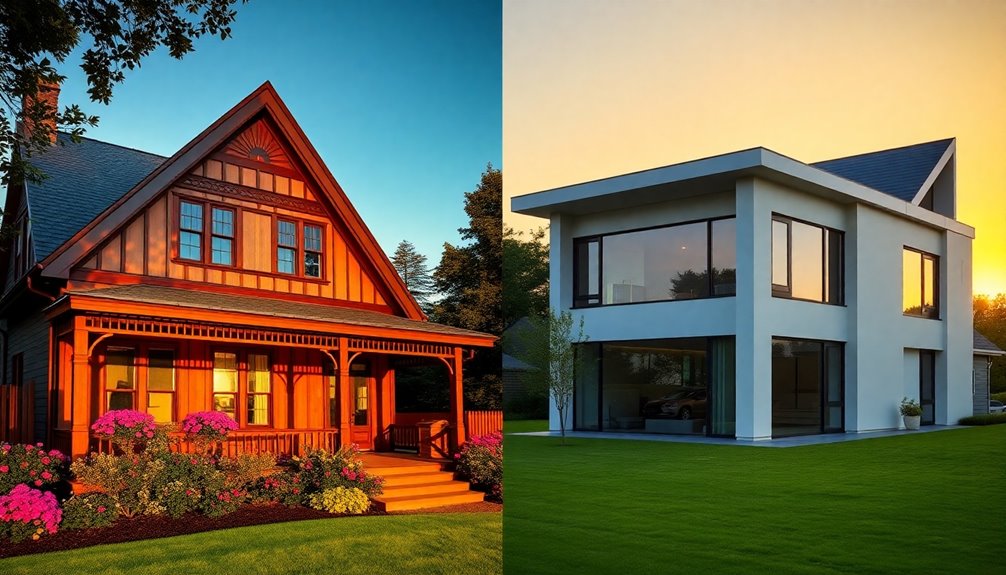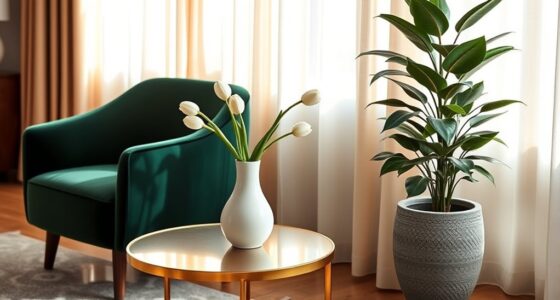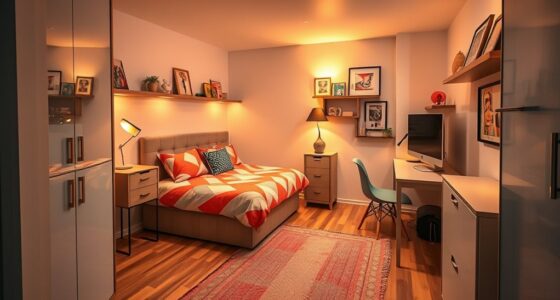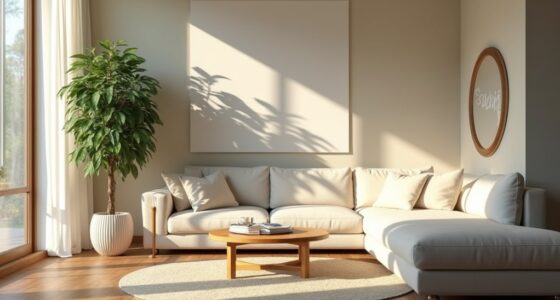Traditional houses have a cozy charm, showcasing ornate details and compartmentalized rooms, which create a warm atmosphere. You'll notice features like gabled roofs and smaller windows that add to their character. In contrast, modern homes focus on minimalism with open layouts that promote interaction and flow. They use large glass panes and neutral colors for a bright, airy feel. Furniture in traditional homes is often substantial, while modern designs emphasize sleek, adaptable pieces. Each style impacts your lifestyle differently. If you're curious about how these differences can influence your living experience, there's much more to explore.
Key Takeaways
- Traditional houses feature symmetrical structures and ornate detailing, while modern houses emphasize minimalism and open layouts with industrial materials like steel and glass.
- Key features of traditional homes include compartmentalized rooms and gabled roofs, whereas modern homes prioritize multi-functional open spaces that encourage social interaction.
- Traditional homes have smaller, ornate windows creating a cozy feel, while modern designs utilize large glass panes and skylights for abundant natural light.
- Furniture in traditional homes is larger and more ornate, while modern furniture is smaller, adaptable, and focused on minimalism and ergonomic comfort.
- Traditional designs evoke nostalgia with formal layouts, while modern architecture promotes a bright, airy environment with seamless connectivity between living areas.
Architectural Styles Overview
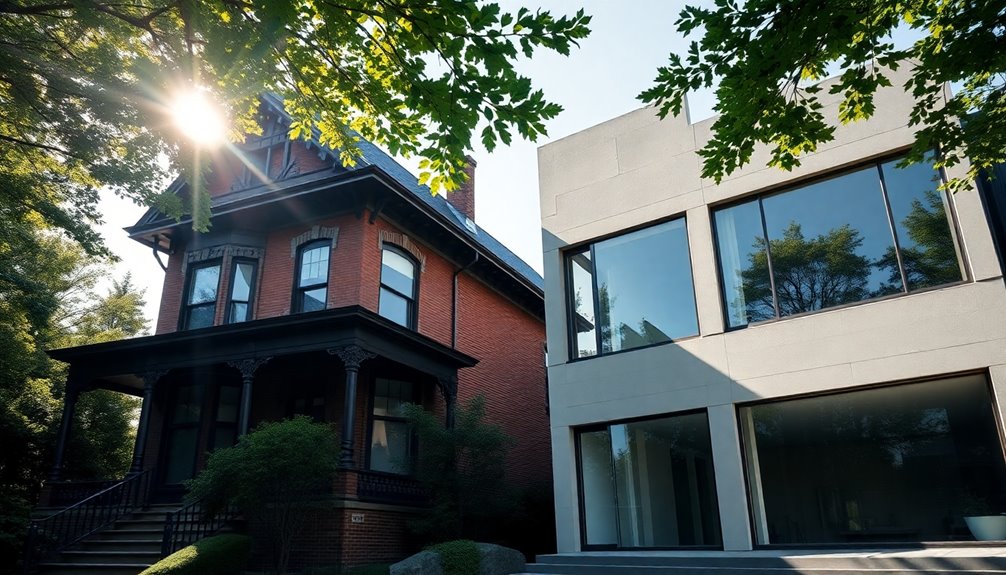
When exploring architectural styles, you'll notice that traditional and modern houses represent two distinct approaches to design.
Traditional architecture often showcases symmetrical structures, ornate detailing, and materials like wood and stone. You'll see features such as gabled roofs and elaborate moldings that reflect historical craftsmanship and cultural significance.
In contrast, modern architecture emphasizes minimalism with open layouts, using industrial materials like steel and glass. This style prioritizes functionality and sustainability, promoting fluid movement through multi-functional spaces.
Aesthetic choices also differ; traditional homes lean towards darker colors and intricate designs, while modern homes favor lighter palettes and simplicity.
These contrasting characteristics highlight the unique philosophies behind traditional and modern architectural styles.
Key Features of Traditional Homes
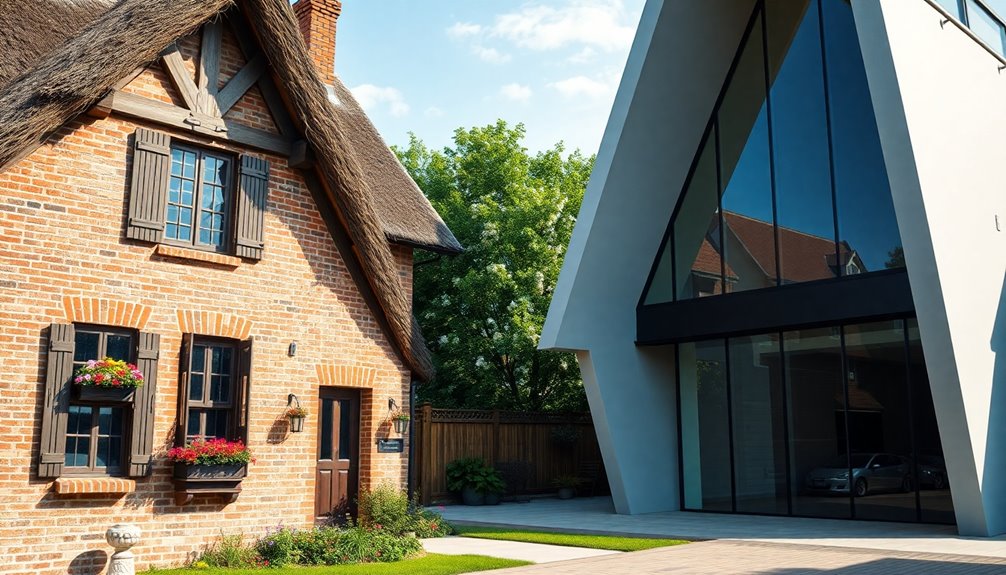
Traditional homes boast a distinctive charm that sets them apart from other architectural styles. You'll notice their symmetrical structures, often highlighted by gabled roofs and dormer windows, enhancing their architectural charm.
These homes reflect a dedication to craftsmanship, featuring intricate woodwork and moldings that showcase meticulous construction and artisanal skills. Inside, traditional designs prioritize coziness, with clearly defined room purposes, like formal dining areas and separate laundry spaces.
Additionally, they commonly employ natural materials such as wood and natural stone, contributing to both the home's longevity and aesthetic appeal. Architectural details like inviting front porches and ornate moldings evoke nostalgia, creating a warm, welcoming atmosphere that connects you to history. Many traditional homes also feature rustic charm through elements like exposed beams and shiplap, enhancing their inviting character.
Key Features of Modern Homes
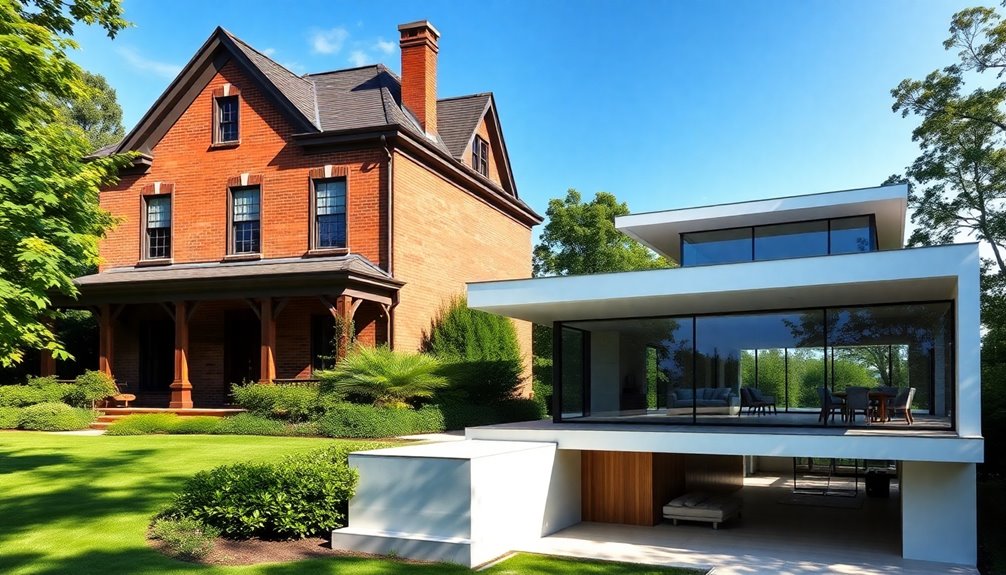
Modern homes stand in stark contrast to their traditional counterparts, emphasizing a more open and flexible approach to living spaces.
You'll notice that modern architecture prioritizes open floor plans, fostering multi-functional areas that enhance interaction among occupants. Large, unornamented windows and skylights flood your home with natural light, creating a seamless connection to the outdoors.
The innovative building materials used—like steel, concrete, and architectural glass—not only boost durability but also promote sustainability.
In the kitchen, sleek designs and high-shine finishes, featuring stainless steel and quartz, reflect a contemporary aesthetic.
Plus, smart home technology makes your life easier, allowing you to control various aspects of your living environment remotely, enhancing convenience and energy efficiency. Additionally, many modern homes incorporate energy-efficient stoves that not only provide warmth but also contribute to reducing heating costs.
Differences in Windows and Lighting
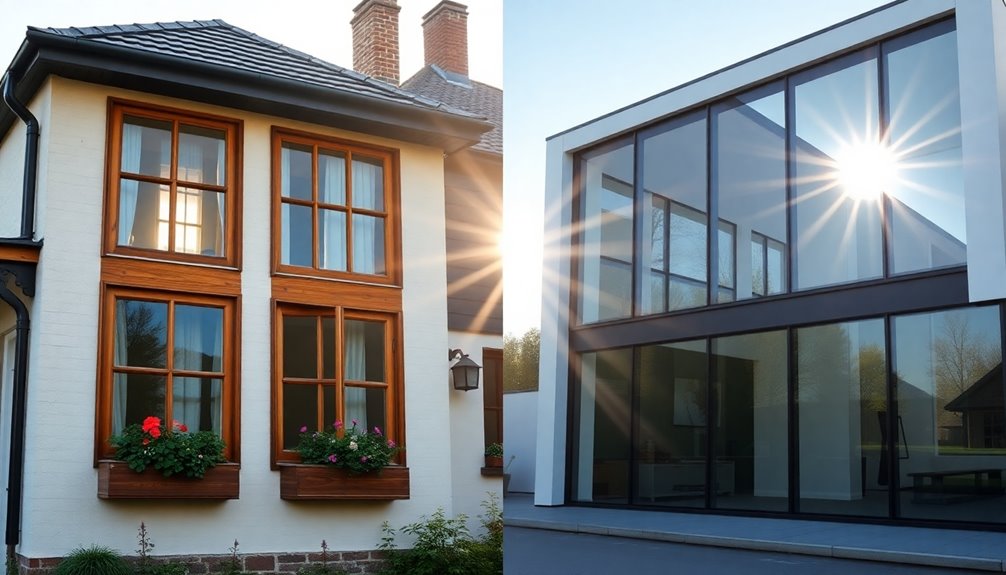
When you compare traditional and modern houses, the differences in windows and lighting are striking.
Traditional homes often feature smaller, ornate windows that create a cozy atmosphere, while modern designs utilize large panes to flood the space with natural light.
You'll also notice that lighting fixtures vary greatly, with elaborate chandeliers in older homes and sleek, minimalist designs in contemporary ones.
Window Styles Comparison
In comparing window styles, you'll notice distinct differences that reflect the unique characteristics of traditional and modern houses.
Traditional homes typically showcase smaller, symmetrical windows adorned with intricate woodwork, while modern architecture leans towards large, unembellished glass windows, enhancing the connection with nature.
You'll find that stained glass and antique lighting are common in traditional designs, compensating for fewer windows. In contrast, modern houses prioritize abundant natural light through expansive windows and skylights.
The geometric window placement in traditional homes creates facade symmetry, whereas modern homes embrace asymmetry for individuality.
Additionally, modern designs often feature energy-efficient double or triple-glazed windows, which greatly improve insulation compared to the single-pane windows commonly found in traditional styles.
Natural Light Utilization
Natural light utilization varies considerably between traditional and modern houses, impacting the overall atmosphere of each style.
In traditional homes, you'll find smaller, symmetrical windows that often limit natural light. These designs may feature intricate woodwork and stained glass, which, while beautiful, restrict light penetration. To brighten interiors, elaborate lighting fixtures are commonly used.
On the other hand, modern architecture embraces large, unornamented windows and skylights, creating a seamless connection with the outdoors. This focus on simplicity and functionality allows natural light to flood the space, resulting in brighter, more inviting living areas.
Consequently, modern homes offer improved indoor air quality and a more open ambiance compared to the typically darker interiors of traditional homes.
Lighting Fixture Choices
While traditional and modern homes both aim to create inviting spaces, their lighting fixture choices reveal significant differences.
Traditional homes often showcase intricate lighting fixtures like chandeliers and sconces, adding warmth and charm. These elaborate designs reflect craftsmanship and compensate for smaller, decorative windows.
In contrast, modern homes embrace minimalist lighting fixtures, such as sleek pendant lights that serve as architectural statements. These designs emphasize simplicity and functionality, mirroring the expansive, unadorned windows that flood interiors with natural light.
While traditional lighting enhances ambiance within geometric, symmetrical spaces, modern lighting connects indoor and outdoor environments, aligning with the overall design philosophy.
Ultimately, your choice of lighting fixtures can dramatically shape the character of your home.
Furniture and Finishes Comparison
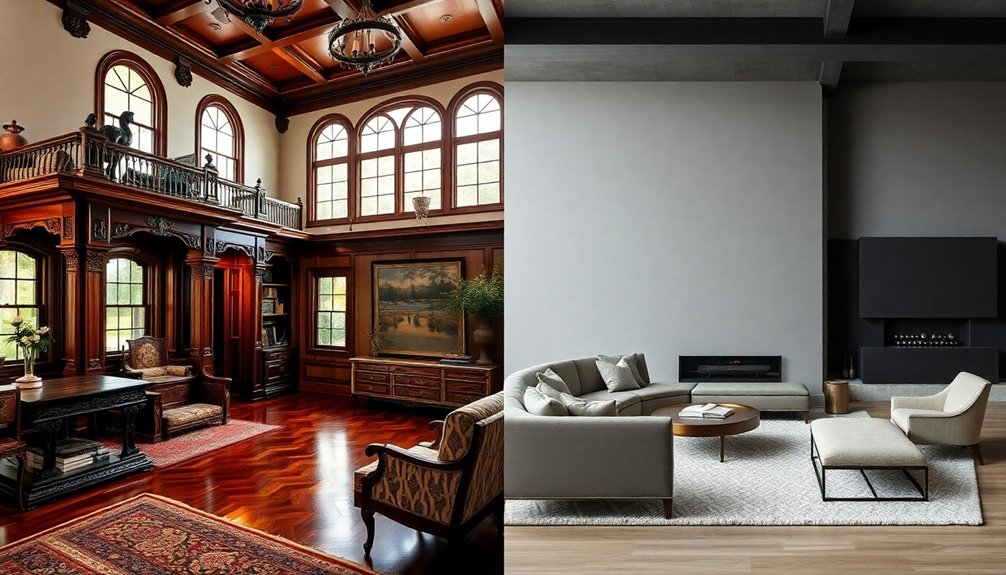
When comparing furniture and finishes in traditional and modern houses, you'll notice distinct differences that reflect each style's philosophy.
Traditional style focuses on ornate designs, heavy woods, and luxurious upholstery, while modern furniture emphasizes minimalism with sleek lines and versatile materials.
Here are some key contrasts:
- Furniture Pieces: Traditional furniture is often larger and more substantial, whereas modern furniture is typically smaller and more adaptable.
- Finishes: You'll find wood-grain cabinetry and decorative finishes in traditional homes, while modern designs prefer painted concrete and laminate for a sleek look.
- Comfort: Both styles prioritize comfort, but modern furniture includes ergonomic elements tailored for today's living needs.
Understanding these differences can help you choose the right style for your space.
Impact of Design on Lifestyle
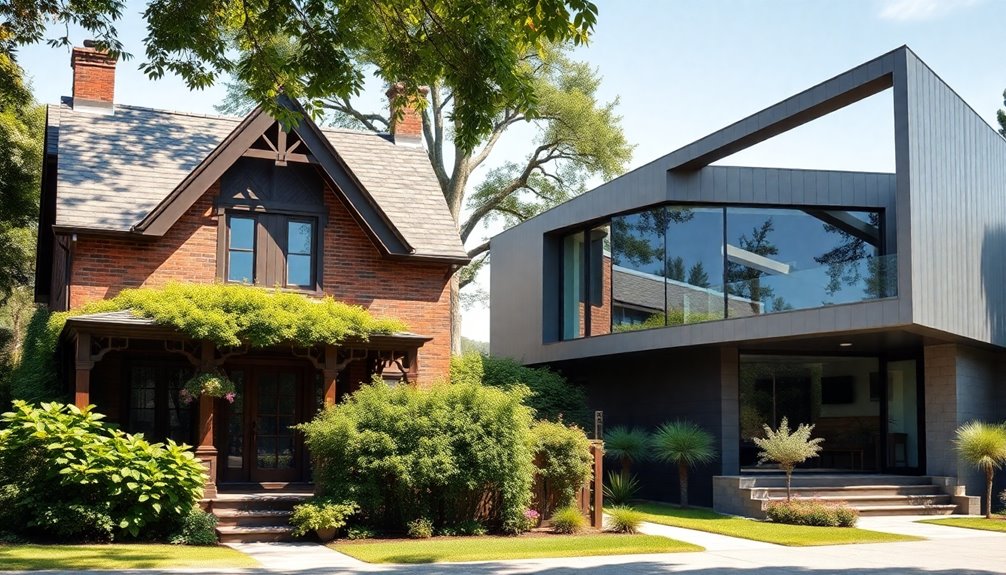
The design of your home shapes how you live every day.
In traditional houses, the segmented spaces can create a structured environment, while modern open-concept layouts encourage interaction and flow.
Plus, the abundance of natural light in modern designs not only brightens your space but can also boost your mood and well-being.
Spatial Organization Differences
Understanding how spatial organization influences lifestyle reveals the stark contrast between traditional and modern houses. Traditional homes often showcase larger floor plans with small, defined rooms that serve single purposes, creating a more compartmentalized atmosphere.
In contrast, modern houses embrace open spaces and multi-functional areas, promoting flexibility and interaction among family members.
Consider these key differences:
- Traditional homes feature formal dining rooms and separate living areas.
- Modern designs prioritize connectivity and flow between spaces.
- Spatial organization in modern architecture fosters a dynamic lifestyle.
This adaptability enhances overall accessibility, allowing you to move seamlessly throughout your home while enjoying a more relaxed and informal environment.
Natural Light Utilization
Natural light plays an essential role in shaping the atmosphere of a home, influencing not just aesthetics but also your overall well-being.
In modern architecture, large, unornamented windows and skylights flood interiors with natural light, creating a bright, airy environment. This design choice fosters a seamless connection with the outdoors, enhancing your mood and improving indoor air quality.
In contrast, traditional homes often feature smaller, symmetrical windows that limit natural light, relying more on artificial sources. Their segmented room layouts can obstruct light movement, resulting in darker, cozier spaces.
If you value abundant natural light, modern homes are designed to elevate your lifestyle, while traditional homes may feel more confined and less invigorating. Additionally, incorporating features like a heat pump can further enhance indoor air quality and comfort by efficiently regulating temperature and humidity levels.
Frequently Asked Questions
What Is the Difference Between Old House and Modern House?
When you look at old houses, you'll notice intricate details like ornate woodwork and gabled roofs, giving them a unique charm.
In contrast, modern houses focus on minimalism, featuring clean lines and open spaces.
Old houses often use wood and stone, while modern ones rely on materials like concrete and glass.
You'll find that old houses have segmented layouts, whereas modern designs promote spaciousness and social interaction, enhancing your living experience.
What Makes a House a Traditional House?
Did you know that over 60% of homeowners prefer traditional designs for their warmth and charm?
A house becomes a traditional house when it features symmetrical structures, gabled roofs, and inviting porches.
You'll notice intricate woodwork and natural materials that reflect craftsmanship.
Inside, cozy, segmented spaces often serve distinct purposes, creating a sense of nostalgia.
These architectural elements not only showcase historical significance but also connect you to cultural heritage.
What Is the Difference Between Traditional and Modern Living?
When you think about traditional and modern living, you notice key differences in space and style.
Traditional living often feels cozy and compartmentalized, with each room serving a specific purpose. In contrast, modern living embraces open-concept layouts that foster connection.
You'll see a focus on minimalism, clean lines, and smart technologies in modern homes, while traditional spaces showcase intricate details and craftsmanship, reflecting a sense of nostalgia and permanence in their design.
What Is the Difference Between Traditional and Modern Buildings?
When you compare traditional and modern buildings, you'll notice distinct characteristics.
Traditional buildings often showcase intricate craftsmanship and historical materials like wood and stone, while modern structures lean toward minimalist designs using steel and glass.
You'll find traditional designs feature symmetry and ornate details, whereas modern architecture embraces open spaces and clean lines.
Additionally, traditional layouts tend to have separate rooms, while modern buildings promote fluidity with open floor plans that enhance versatility.
Conclusion
In the dance of architecture, traditional homes waltz gracefully with history, their intricate details echoing timeless stories. Meanwhile, modern homes sprint forward, embracing minimalism and innovation. As you step into these contrasting worlds, imagine a tapestry woven with rich patterns in one hand and a sleek, polished canvas in the other. Ultimately, whether you cherish the warmth of tradition or the allure of modernity, your choice reflects your unique rhythm in life's grand symphony.
